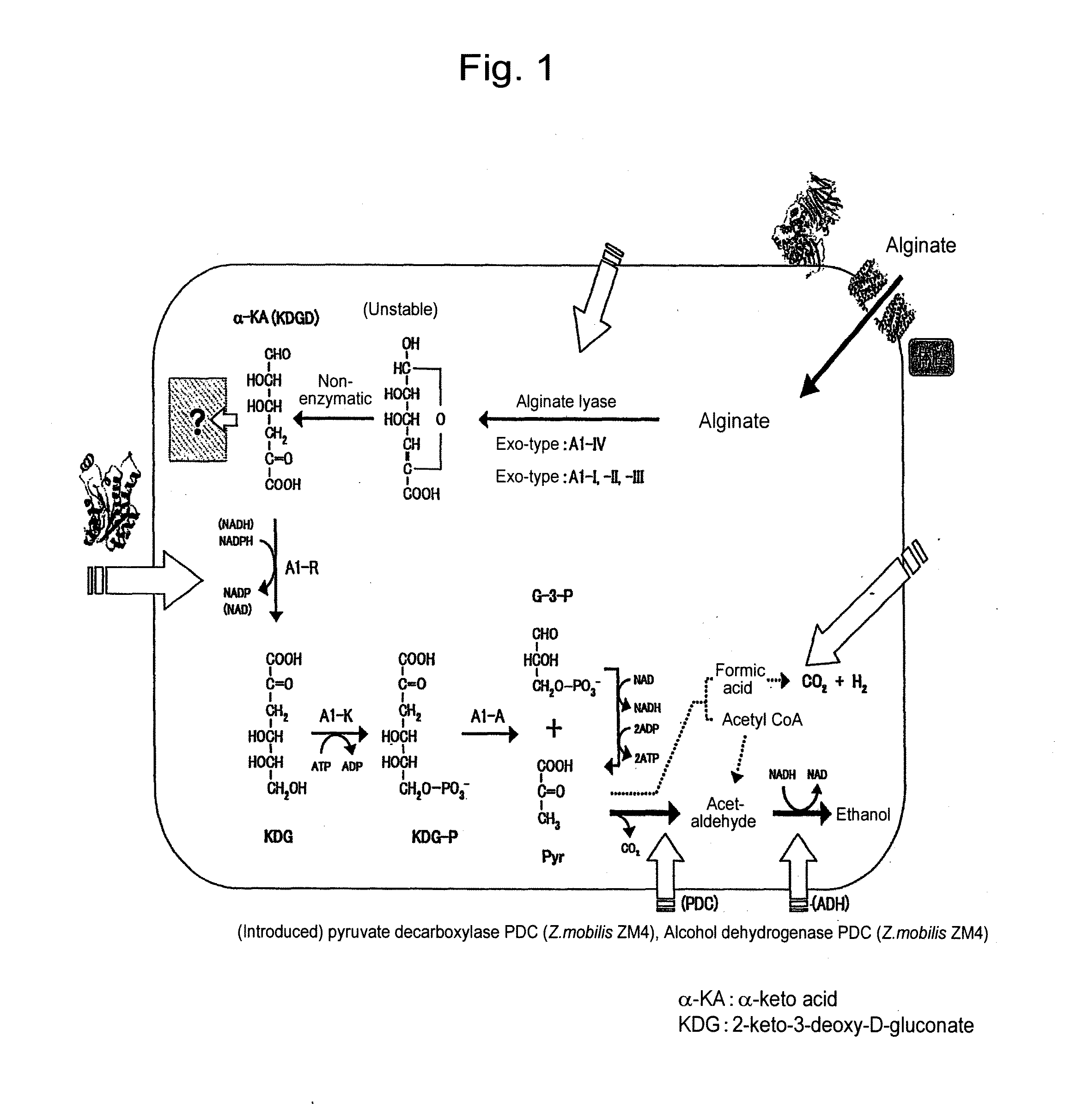Ethanol production from ocean biomass
- Summary
- Abstract
- Description
- Claims
- Application Information
AI Technical Summary
Benefits of technology
Problems solved by technology
Method used
Image
Examples
example 1
Molecular Breeding (1) of Strain A1 (Bacteria Belonging to the genus Sphingomonas)
Materials
[0077]As the strain A1 (bacterium belonging to the genus Sphingomonas (hereinafter, strain A1)), frozen cells stored as a glycerol stock at the Murata laboratory, Division of Food Science and Biotechnology, Graduate School of Agriculture, Kyoto University were used as starter bacteria. The Zymomonas mobilis strain ZM4 (ATCC31821) was purchased from the American Type Culture Collection (ATCC). Eisenia bicyclis-derived sodium alginate (average molecular size of 110 kDa; degree of polymerization of up to 650) was purchased from NACALAI TESQUE, INC. Restriction enzymes were purchased from Takara Bio Inc. and Fermentas, and DNA modification enzymes were purchased from Toyobo Co., Ltd. Special grade products were purchased as other compounds from Wako Pure Chemical Industries, Ltd.
Microorganisms and Culture Conditions
[0078]Cells of the strain A1 were aerobically cultured in an alginate medium at 30°...
example 2
Ethanol Production by Strain A1 (Bacteria Belonging to the genus Sphingomonas)
Materials
[0087]Eisenia bicyclis-derived sodium alginate (average molecular size of 110 kDa; degree of polymerization of up to 650) was purchased from NACALAI TESQUE, INC. For ethanol quantification by an enzyme method, an F-kit (ethanol) was purchased from Roche Diagnostics. Special grade products were purchased as other compounds from Wako Pure Chemical Industries, Ltd.
Preparation of Alginate Oligosaccharide
[0088]An Escherichia coli strain (HMS174 (DE3) pLysS / pET3a-A1-III) expressing strain A1 (of bacteria belonging to the genus Sphingomonas)-derived endo-alginate lyase A1-III at high levels (Yoon et al., 2000) was pre-cultured using a Luria-Bertani (LB) medium (Sambrook et al., 1989) containing ampicillin (0.1 mg / mL) at 30° C. and 100 rpm. Subsequently, when turbidity at 600 nm was 0.5, isopropyl-β-D-thiogalactopyranoside was added to the medium to a final concentration of 0.1 mM, and then cells were fur...
example 3
Strain A1 (Bacteria Belonging to the genus Sphingomonas) Becoming Resistant (Developing Tolerance) to Ethanol
Materials
[0094]For the strain A1 (hereinafter, the strain A1) of bacteria belonging to the genus Sphingomonas, frozen cells stored in the form of glycerol stock at the Murata laboratory, Division of Food Science and Biotechnology, Graduate School of Agriculture, Kyoto University, were used as starter bacteria. Eisenia bicyclis-derived sodium alginate (average molecular size of 110 kDa; degree of polymerization of up to 650) was purchased from NACALAI TESQUE, INC. Special grade products were purchased as other compounds from Wako Pure Chemical Industries, Ltd.
Microorganisms and Culture Conditions
[0095]Cells of the strain A1 were aerobically cultured in an alginate medium at 30° C. and 100 spm for 48 hours. The composition of the alginate medium is as follows: 0.1% (NH4)2SO4, 0.1% KH2PO4, 0.1% Na2HPO4, 0.01% MgSO4.7H2O, 0.01% yeast extract, and 0.5% sodium alginate (pH 7.2). Al...
PUM
 Login to View More
Login to View More Abstract
Description
Claims
Application Information
 Login to View More
Login to View More - R&D
- Intellectual Property
- Life Sciences
- Materials
- Tech Scout
- Unparalleled Data Quality
- Higher Quality Content
- 60% Fewer Hallucinations
Browse by: Latest US Patents, China's latest patents, Technical Efficacy Thesaurus, Application Domain, Technology Topic, Popular Technical Reports.
© 2025 PatSnap. All rights reserved.Legal|Privacy policy|Modern Slavery Act Transparency Statement|Sitemap|About US| Contact US: help@patsnap.com



